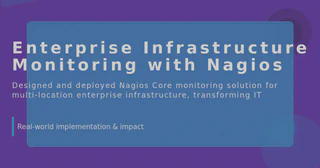Enterprise Infrastructure Monitoring with Nagios

Overview
In 2015, I architected and deployed Nagios Core monitoring infrastructure for a multi-location restaurant chain’s enterprise IT environment. The solution provided comprehensive visibility into on-premises datacenter infrastructure, virtual machines, network equipment, and mission-critical business applications serving all corporate departments.
Strategic validation through homelab deployment de-risked the production rollout and provided operational experience before enterprise implementation.
Highlights
- Reduced Mean Time to Detection (MTTD) from hours to minutes through automated alerting and comprehensive service monitoring
- Improved incident response by transforming IT operations from reactive (user-reported issues) to proactive (automated detection and escalation)
- Monitored critical infrastructure including VMware virtualization platform, network switches/routers, and business-critical applications (payment processing, POS integration, inventory management)
- Validated architecture through homelab deployment before production rollout, demonstrating proof-of-concept and building stakeholder confidence
- Enabled strategic IT focus by reducing firefighting and allowing support team to prioritize proactive maintenance and improvement projects
Technical Architecture
- Monitoring server: Nagios Core on dedicated VM with NRPE for remote Linux server checks
- Network monitoring: SNMP integration for switches, routers, and network edge devices across multiple locations
- Service monitoring: Custom plugins for application-specific health checks and business process monitoring
- Alert management: Configurable escalation policies, dependency handling, and multi-channel notifications
- Low operational overhead: Lightweight deployment requiring minimal resources while providing enterprise-grade reliability
Business Impact
Transformed IT operations model from reactive incident response to proactive infrastructure management. Early detection of infrastructure issues prevented business disruptions, improved service availability, and enabled data-driven capacity planning decisions.
The monitoring system became a critical operational tool, providing visibility that had previously required manual checks or waiting for user-reported problems.
Next Steps
While Nagios continues serving stable, on-premises environments effectively, modern cloud-native infrastructure benefits from complementary tools like Prometheus for metrics and distributed tracing solutions for application observability. The architectural principles—comprehensive monitoring, intelligent alerting, and proactive operations—remain timeless.